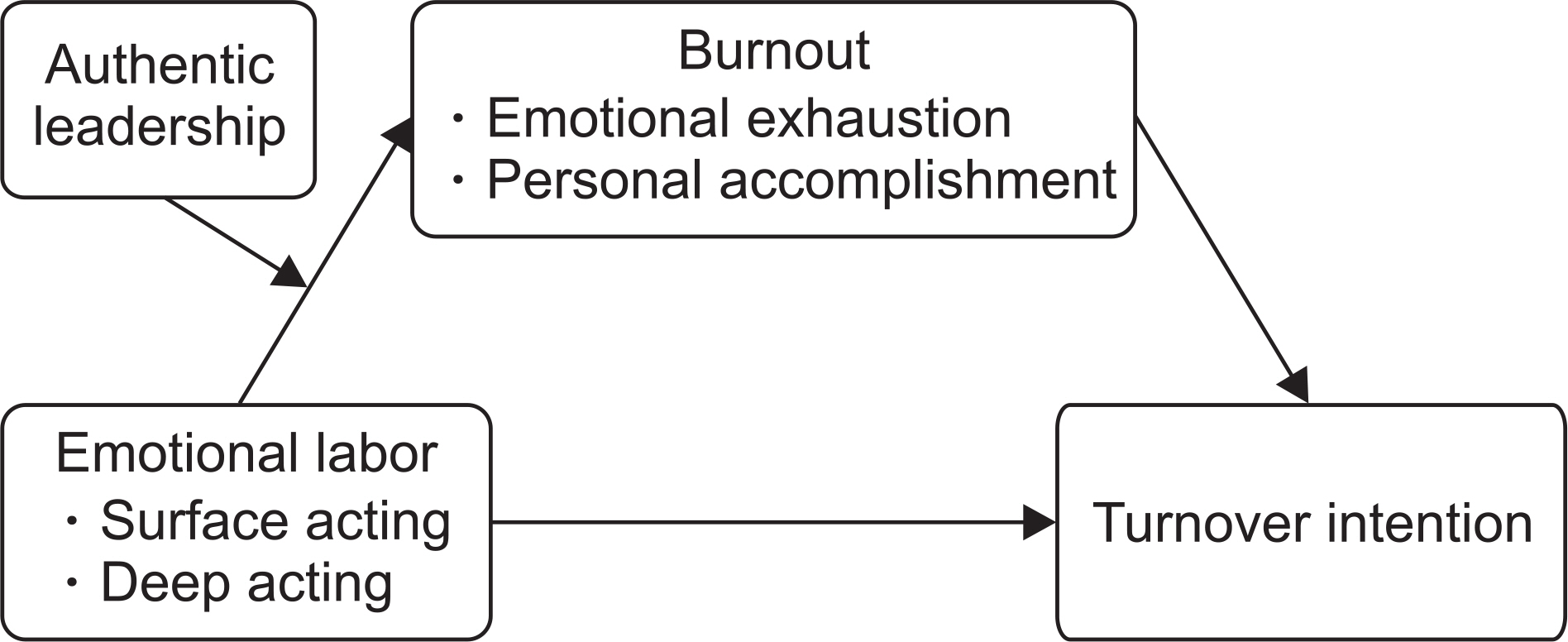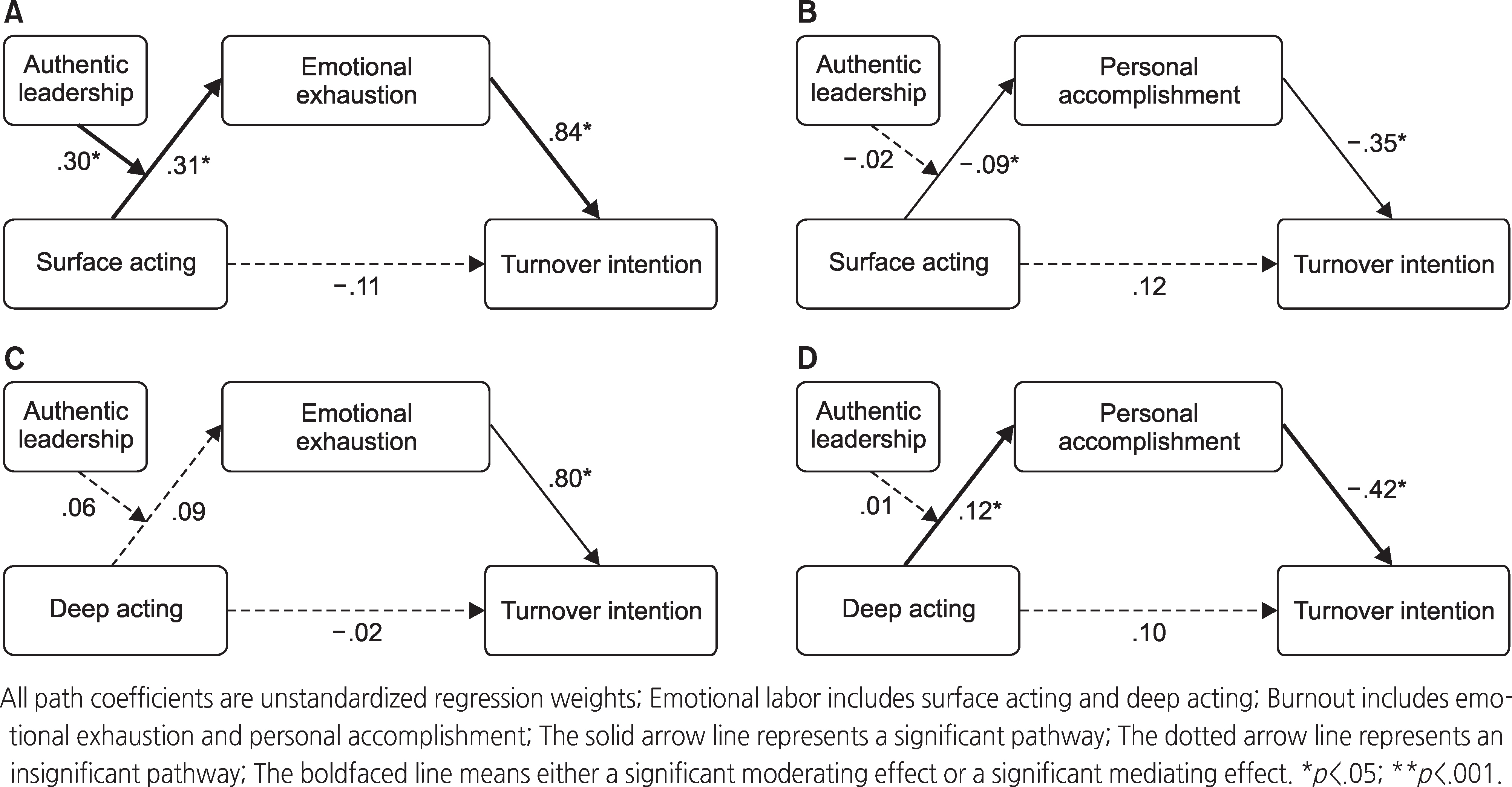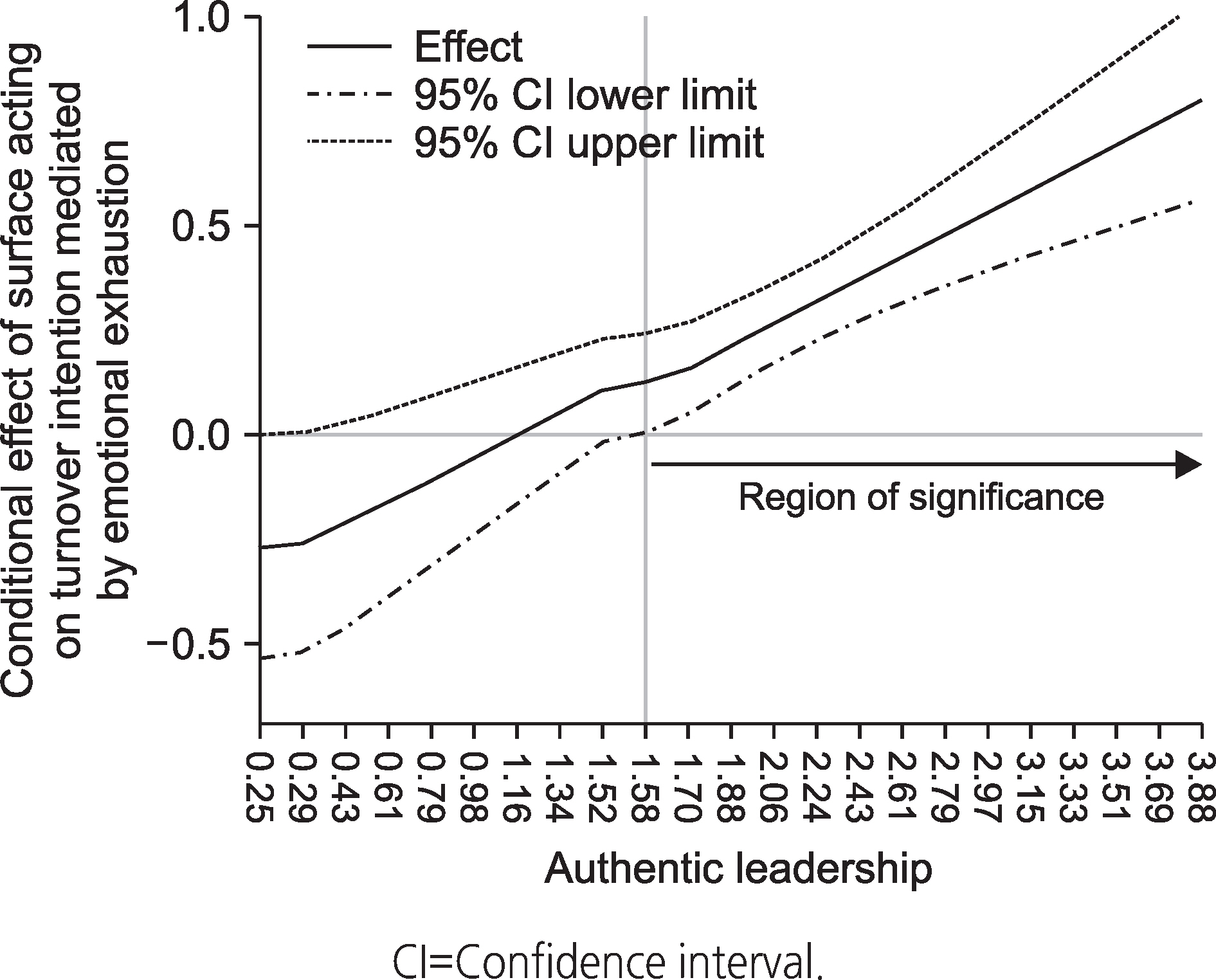J Korean Acad Nurs.
2019 Jun;49(3):286-297. 10.4040/jkan.2019.49.3.286.
The Effect of Nurse's Emotional Labor on Turnover Intention: Mediation Effect of Burnout and Moderated Mediation Effect of Authentic Leadership
- Affiliations
-
- 1College of Nursing Science, Kyung Hee University, Seoul, Korea.
- 2College of Nursing, The Catholic University of Korea, Seoul, Korea. hparkchicago@gmail.com
- KMID: 2451296
- DOI: http://doi.org/10.4040/jkan.2019.49.3.286
Abstract
- PURPOSE
To investigate the effect of nurses' emotional labor on their turnover intention that was mediated by burnout and to examine the moderated mediation effect of authentic leadership.
METHODS
A total of 227 nurses working at two general hospitals in Seoul were recruited from March 21 to May 6 in 2016. Emotional labor including surface acting and deep acting; burnout factors such as emotional exhaustion and personal accomplishment; and turnover intention were assessed. The data were analyzed using SPSS 22.0 and SPSS PROCESS macro.
RESULTS
Surface acting significantly increased emotional exhaustion and reduced personal accomplishment. Deep acting significantly increased personal accomplishment. Emotional exhaustion significantly increased turnover intention. Conversely, personal accomplishment significantly reduced turnover intention. Surface acting had an indirect effect on turnover intention that was mediated by emotional exhaustion. Deep acting had an indirect effect on turnover intention that was mediated by personal accomplishment. Authentic leadership had a moderated mediation effect on the relationship between surface acting and turnover intention that was mediated by emotional exhaustion.
CONCLUSION
The findings of this study indicate that the establishment of strong authentic leadership by head nurses would help nurses reduce their burnout and turnover intention. Conducting intervention studies would be also important to promote better work environments that would enable nurses to fortify the positive aspect of emotional labor and to reduce their burnout levels.
Keyword
MeSH Terms
Figure
Reference
-
References
1. Ministry of Health and Welfare (MOHW). Work environment of nurses and treatment improvement countermeasure [Internet]. Sejong: MOHW;c2018. [cited 2018 Jun 1]. Available from:. http://www.mohw.go.kr.2. Lee SY. Expansion of hospital staff: Top priority for promoting patient safety. Seoul: Public Policy Institute for People;c2015. [cited 2018 Dec 15]. Available from:. http://www.ppip.or.kr/board_BHCY31/1138.3. Cheng C, Bartram T, Karimi L, Leggat SG. The role of team climate in the management of emotional labour: Implications for nurse retention. Journal of Advanced Nursing. 2013; 69(12):2812–2825. https://doi.org/10.1111/jan.12202.
Article4. Lee MA, Kim E. Influences of hospital nurses’ perceived reciprocity and emotional labor on quality of nursing service and intent to leave. Journal of Korean Academy of Nursing. 2016; 46(3):364–374. https://doi.org/10.4040/jkan.2016.46.3.364.
Article5. Bartram T, Casimir G, Djurkovic N, Leggat SG, Stanton P. Do perceived high performance work systems influence the relationship between emotional labour, burnout and intention to leave? A study of Australian nurses. Journal of Advanced Nursing. 2012; 68(7):1567–1578. https://doi.org/10.1111/j.1365-2648.2012.05968.x.
Article6. Zhang Y, Feng X. The relationship between job satisfaction, burnout, and turnover intention among physicians from urban state-owned medical institutions in Hubei, China: A cross-sectional study. BMC Health Services Research. 2011; 11:235. https://doi.org/10.1186/1472-6963-11-235.
Article7. Karimi L, Leggat SG, Donohue L, Farrell G, Couper GE. Emotional rescue: The role of emotional intelligence and emotional labour on well‐being and job‐stress among community nurses. Journal of Advanced Nursing. 2014; 70(1):176–186. https://doi.org/10.1111/jan.12185.
Article8. Hochschild AR. Emotion work, feeling rules, and social structure. American Journal of Sociology. 1979; 85(3):551–575. https://doi.org/10.1086/227049.
Article9. Han S. Current status of emotional labor by occupation. Seoul: Korea Research Institute for Vocational Education & Training;c2013. [cited 2018 Dec 15]. Available from:. https://www.kriv-et.re.kr/ku/da/kuBDCVw.jsp?gn=G7-E520130008.10. Grandey AA. Emotional regulation in the workplace: A new way to conceptualize emotional labor. Journal of Occupational Health Psychology. 2000; 5(1):95–110. https://doi.org/10.1037/1076-8998.5.1.95.
Article11. Maslach C, Jackson SE. The measurement of experienced burnout. Journal of Organizational Behavior. 1981; 2(2):99–113. https://doi.org/10.1002/job.4030020205.
Article12. Jin Y, Song KC. Mediating role of job burnout and moderating role of social support in the relationships among job stressors, emotional labor, and job satisfaction. Korean Journal of Human Resource Development. 2012; 15(2):1–36.13. Laschinger HKS, Wong CA, Grau AL. The influence of authentic leadership on newly graduated nurses’ experiences of workplace bullying, burnout and retention outcomes: A cross-sectional study. International Journal of Nursing Studies. 2012; 49(10):1266–1276. https://doi.org/10.1016/j.ijnurstu.2012.05.012.
Article14. Maslove L, Fooks C. Our health, our future: Creating quality workplaces for Canadian nurses: A progress report on implementing the final report of the Canadian Nursing Advisory Committee [Internet]. Ottawa (ON): Canadian Policy Research Networks;c2004. [cited 2018 Dec 15]. Available from:. http://www.cwhn.ca/en/node/25288.15. Avolio BJ, Gardner WL, Walumbwa FO, Luthans F, May DR. Unlocking the mask: A look at the process by which authentic leaders impact follower attitudes and behaviors. The Leadership Quarterly. 2004; 15(6):801–823. https://doi.org/10.1016/j.leaqua.2004.09.003.
Article16. Shirey MR. Authentic leaders creating healthy work environments for nursing practice. American Journal of Critical Care. 2006; 15:256–267.
Article17. Yun J. Authentic leadership of head nurse, burnout and job satisfaction of nurse: Mediating effect of positive psychological capital [master’s thesis]. Busan: Pusan National University;2016. p. 1–70.18. Jang J, Kim H. Surface acting, emotional exhaustion and turnover intention: A moderated mediation model of leader-member exchange. Korean Journal of Business Administration. 2016; 29(7):1129–1150. https://doi.org/10.18032/kaaba.2016.29.7.1129.
Article19. Hayes AF. Introduction to mediation, moderation, and conditional process analysis: A regression-based approach. 2nd ed. New York: The Guilford Press;2018. p. 1–112. 393-468.20. Cottingham MD, Erickson RJ, Diefendorff JM. Examining men’s status shield and status bonus: How gender frames the emotional labor and job satisfaction of nurses. Sex Roles: A Journal of Research. 2015; 72(7-8):377–389. https://doi.org/10.1007/s11199-014-0419-z.
Article21. Morris JA, Feldman DC. The dimensions, antecedents, and consequences of emotional labor. The Academy of Management Review. 1996; 21(4):986–1010. https://doi.org/10.2307/259161.
Article22. Jourdain G, Chênevert D. Job demands-resources, burnout and intention to leave the nursing profession: A questionnaire survey. International Journal of Nursing Studies. 2010; 47(6):709–722. https://doi.org/10.1016/j.ijnurstu.2009.11.007.
Article23. Cho YK. A structural equation model on new graduate nurses’ turnover intentions and turnover [dissertation]. Seoul: Ewha Woman’s University;2013. p. 1–128.24. Hair JF, Black WC, Babin BJ, Anderson RE. Multivariate data analysis. 7th ed. Upper Saddle River (NJ): Pearson Prentice Hall;2010. p. 541–598.25. Wayne SJ, Shore LM, Liden RC. Perceived organizational support and leader-member exchange: A social exchange perspective. Academy of Management Journal. 1997; 40(1):82–111. https://doi.org/10.5465/257021.
Article26. Lee J, Kwak WJ. The effect of supervisor’s turnover intention on subordinate’s turnover intention: Interaction effect between turnover intention, LMX and POS. Korean Corporation Management Review. 2017; 24(3):117–136.27. Lyons TF. Role clarity, need for clarity, satisfaction, tension, and withdrawal. Organizational Behavior and Human Performance. 1971; 6(1):99–110. https://doi.org/10.1016/0030-5073(71)90007-9.
Article28. Brotheridge CM, Lee RT. Development and validation of the Emotional Labour Scale. Journal of Occupational and Organizational Psychology. 2003; 76(3):365–379. https://doi.org/10.1348/096317903769647229.
Article29. Seo MR. The psychometric validation of Emotional Labor Scale with staff nurses [master’s thesis]. Gwangju: Chosun University;2013. p. 1–26.30. Walumbwa FO, Avolio BJ, Gardner WL, Wernsing TS, Peterson SJ. Authentic leadership: Development and validation of a theory-based measure. Journal of Management. 2008; 34(1):89–126. https://doi.org/10.1177/0149206307308913.
Article31. Kim MR, Seomun GA. Relationships among burnout, job satisfaction, organizational commitment and turnover intention to resign in hospital nurses. Korean Journal of Occupational Health Nursing. 2013; 22(2):93–101. https://doi.org/10.5807/kjohn.2013.22.2.93.
Article
- Full Text Links
- Actions
-
Cited
- CITED
-
- Close
- Share
- Similar articles
-
- Mediating Effects of Burnout in the Association Between Emotional Labor and Turnover Intention in Korean Clinical Nurses
- Mixed Method Research Investigating Turnover Intension with ICU Nurses
- Moderated Mediation Effect of Mindfulness on the Relationship Between Muscular Skeletal Disease, Job Stress, and Turnover Among Korean Firefighters
- Effects of Nursing Unit Managers’ Authentic Leadership, Transformational Leadership, and Transactional Leadership on Turnover Intention in Advanced Beginner Nurses: Mediation Effects of Positive Psychological Capital
- Effects of Job Crafting, Burnout, and Job Satisfaction on Nurses' Turnover Intention: A Path Analysis




